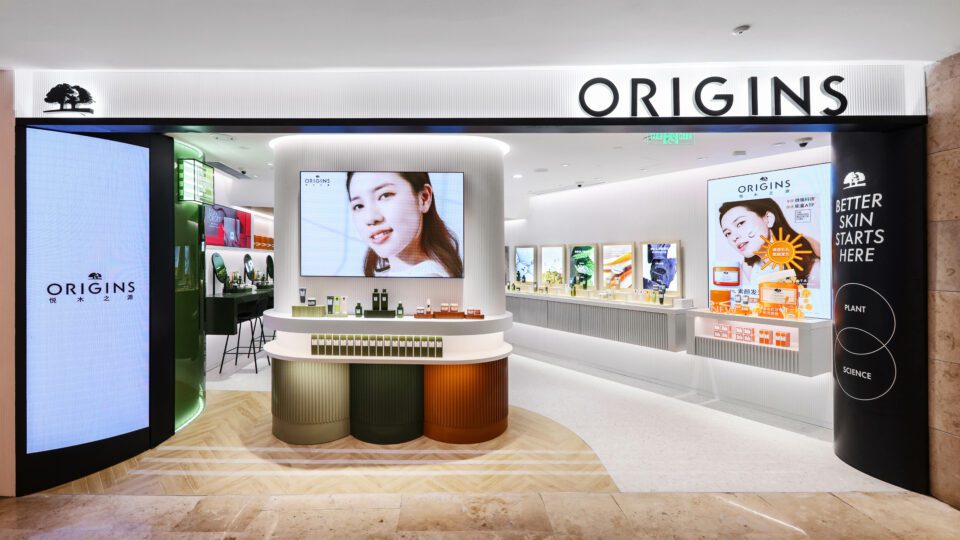Earlier this summer, the Estée Lauder Companies (ELC) announced the launch of a new Responsible Store Design Program to advance its progress toward environmental targets. While the company has made significant progress in green chemistry, supply chain, climate, biodiversity and more, this new program will put sustainability at the center of both new and existing retail store designs.
At the core of the store design program is a framework to assess retail stores and to inform the design of ELC visual merchandising, based on sustainability-related areas including waste reduction, water and energy conservation and responsible material sourcing. ELC is developing an internal target to align all new store openings with the program, and has identified 50+ existing stores it plans to align with the program guidelines through 2024. At the same time, the company will “continue to test the program with new store types and in new locations to scale our work across our retail footprint,” explained Al Iannuzzi, VP of Sustainability for ELC in an interview with Retail TouchPoints.
Iannuzzi offered detailed insights on:
- The evolution of ELC’s sustainability strategy;
- Why it was time to bring store design into broader environmental, social, and corporate governance (ESG) discussions;
- How the company is driving education, engagement and alignment around the new Responsible Store Design Program; and
- How the company is setting and measuring against store design goals.
Retail TouchPoints (RTP): How would you describe ELC’s sustainable store design practices prior to the launch of the Responsible Store Design program and Green Building Standards?
Al Iannuzzi: Sustainability has long been part of our corporate strategy and company culture, and our new Responsible Store Design program is a creative and impactful way to showcase ELC’s sustainability commitments to both our employees and our consumers.
Advertisement
Prior to the launch of Responsible Store Design, ELC finalized our internal Green Building Standards for all our spaces in the 2020 fiscal year. These standards, which included guidance on retail sustainability, served as a roadmap to help both new construction and major renovations incorporate sustainability principles into their design, and to set a baseline for practices covering materials, energy, water, waste and indoor air quality.
A checklist of core practices was provided to retail design teams to implement, which included specifications like LED lighting, low-flow plumbing fixtures, in-store recycling and end-of-day shutdown. To support our designers’ selection of responsible materials for retail spaces, we developed a robust scoring framework. Scores are based on criteria such as material composition, third-party certifications and end-of-life considerations. As of fiscal year 2023, we have scored our largest brands and are working with them to identify alternate materials where appropriate. We meet regularly with our Retail Leadership Council and regional design teams to check in on progress and assess new opportunities for sustainability improvements.
Building on these standards, the Responsible Store Design program is the pinnacle of our retail sustainability journey to date and an evolution of our retail sustainability practices. Responsible Store Design expands on historic efforts, capturing new impact areas like store buildout and operations, which were informed by leading green buildings standards like LEED and WELL to ensure a holistic program approach.
RTP: Why was a standardized and documented initiative critical?
Iannuzzi: In sustainability, you often hear the phrase ‘you can’t manage what you don’t measure,’ so setting up a clear checklist of program requirements to streamline implementation for our teams, and tracking progress on an annual basis, will be essential factors for Responsible Store Design’s success.
Our hope is that this consumer-facing initiative also engages consumers in our sustainability journey. The program serves as a roadmap to help ensure new construction and major renovations incorporate green building principles into their design, so we can integrate sustainability from product to store and make key claims to bring consumers along.
RTP: Prior to the launch of the program, ELC worked with its brands and global retail design teams to incorporate sustainability into their store design and visual merchandising. How did you go about aligning and rallying teams around these initiatives previously, and how will a more defined program support adoption?
Iannuzzi: We have several vehicles and champions for this work. Our management-led Green Building Committee meets quarterly to make certification decisions for new spaces, and our internal Retail Sustainability Leadership Council meets quarterly to further drive sustainability efforts in retail spaces. Through these and other regular workstream meetings, we were able to coordinate with regional and brand store design teams to develop, approve and launch the Responsible Store Design Program.
There is a lot of appetite for the program internally, as this program presents an opportunity for our brands to showcase their hard work and leadership in the retail sustainability space. We believe that having a more defined approach through a clear, branded program will not only support our retail design teams in incorporating the core sustainability practices but will help to engage consumers on our sustainability journey as well.
RTP: How do the guidelines/goals for the Responsible Store Design Program support or feed into ELC’s broader sustainability goals and measures?
Iannuzzi: Climate action, waste reduction, water stewardship and the responsible sourcing of materials are all foundational to our approach to environmental sustainability at ELC and are key components of the Responsible Store Design program. Many of the prerequisites for our program directly correlate to emissions reductions, including procuring renewable electricity, reducing energy usage through LED lighting and Energy Star-rated equipment and sourcing low-emissions materials for store design and visual merchandising. Other practices, like waste management and efficient plumbing fixtures, help to better connect these key tenets of our internal Green Building Standards back to our retail spaces.
In support of these environmental commitments, we’re proud to take our retail sustainability efforts to the next level. The Responsible Store Design program was developed with the assistance of a sustainability consulting firm with expertise in green building design and reviewed by a third party to assure its credibility and accuracy.
RTP: How has the team gone about setting realistic yet meaningful goals for the program, and what procedures are in place for measuring progress?
Iannuzzi: The program is not currently mandatory, but as we scale the Responsible Store Design program, we expect to set an internal target for our new stores to align with the program in the future. The store framework was developed to engage all our store types — new stores, existing stores and visual merchandising — in the program, and we expect to see representation across each of these categories as the program scales.
RTP: Who is leading in developing and refining standards for the overall program?
Iannuzzi: Our Global Corporate Citizenship & Sustainability team has been leading the development of Responsible Store Design, but this program is a multi-year collaboration between retail design, environmental health and safety, travel retail and brand store design teams.
RTP: How do you ensure alignment and adherence to sustainability practices for your retail stores, especially among retail wholesale partners?
Iannuzzi: In fiscal 2022, we formed an internal Retail Sustainability Leadership Council to further drive sustainability efforts in retail spaces. For example, thoughtful materials selection is a key priority to design and outfit stores, counters and visual merchandising. We focus on replacing virgin materials with recycled, bio-based sources and on using Forest Stewardship Council (FSC)-certified cardboard, paper and woods where possible.
We also consider end-of-life when designing fixtures and visual merchandising, with an emphasis on modular design, easy disassembly, and prioritization of recyclable materials. Our teams work together to incorporate these sustainable materials into store guidelines and vendor requests, so that as we work with contractors and other vendors, these core practices are baked in from the beginning of the store design process.
Additionally, to support our designers’ selection of furniture and finishes for retail spaces, we have developed a robust material scoring framework. Scores are based on criteria such as material composition, third-party certifications and end-of-life considerations. We have scored our largest brands and are working with them to identify alternate materials where appropriate.
RTP: How do you drive education, engagement and internal championing, not just within the design team but among other influencers that can drive meaningful impact internally?
Iannuzzi: ELC’s approach to sustainable building operations includes all buildings, from retail to offices and supply chain sites. ELC has appointed sustainability champions within our largest existing offices globally to help implement green office best practices and formally incorporated this responsibility into their personal development plans. Champions conduct benchmarking to identify areas for improvement and partner with key stakeholders at their local office to implement best practices.
Champions are also encouraged to engage fellow employees in sustainability efforts through education and events. In the 2022 fiscal year, there were 85 champions representing more than 62 offices worldwide, and 11 of these offices have implemented 100% of our core sustainability practices. Outside of offices, we host regular webinars, cross-functional workstream meetings and leadership councils and committees to ensure alignment and support for our retail sustainability efforts across the business.
RTP: Seven ELC stores have successfully aligned with the new framework as part of the 2023 FY pilot program. What are your goals for the next one to two years?
Iannuzzi: As the program grows, we will continue to monitor consumer insights to ensure the program is as effective as possible and conveys ELC’s values around sustainability in a genuine and powerful way. The program will grow with us as we strengthen our sustainability commitments and continue to work closely with brands and regional design teams on retail sustainability initiatives.
ELC frequently shares its programs and learnings through our participation in various industry groups and in our annual Social Impact & Sustainability report. As we launch Responsible Store Design, we will continue to report on our progress to our key stakeholders, share our findings with our peers and look for opportunities to collaborate and scale other green building initiatives.
















